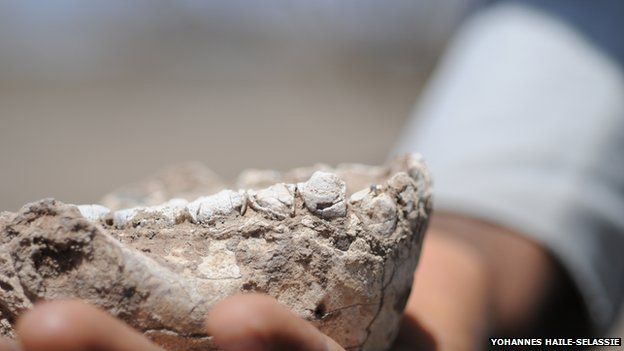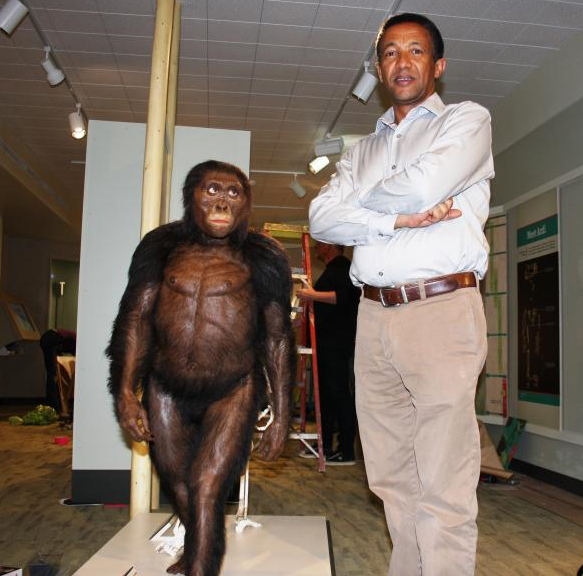


Response to New Human Species Claim: the reaction to the recent discovery of a new human species, based on the fossil findings of the jaws and teeth, living alongside Lucy 3.4 million years ago.

In an article by Jeff St. Clair on wksu.org - Some scientists disagree with new fossil findings - we learn of the reaction to the recent discovery of a new human species, based on the jaws and teeth, living alongside Lucy 3.4 million years ago.
Cleveland Museum of Natural History curator Yohannes Haile-Selassie claims the jaw bones and teeth found recently in Ethiopia belong to a new species of early human that lived alongside a more commonly known ancestor.

Not so, says Kent State University professor Owen Lovejoy, who was part of the team in 1974 which discovered the famous specimen known as Lucy. He claims the teeth are not that different than Lucy's.
The debate comes down to how a new species is designated. A species is the fundamental taxonomic category used in biology. It is a very difficult judgement to make, especially in the fossil record where you are invariably looking at only a small portion of the animal, in this case, some teeth and jaws. The judgement is whether or not this constitutes a new lineage that lies outside the variation expected. The ranges of variation in scientific communities are, ironically, subjective.
In this case, Lovejoy argues that you are comparing things like molar and enamel thickness and size, and various characteristics of the dentition, and having to make the judgement as to whether these are significantly different than anything we have seen in Lucy's species to justify a new lineage.
Which he believes is not the case. Nor does Lucy co-discoverer Tim White at Berkeley, one of Haile-Selassie's mentors, and William Kimble, director of the Institute of Human Origins at Arizona State University.
Why? Lovejoy says it is down to habitat; part of his skepticism stems from the behavioral implications of adding a new species to the habitat occupied by Lucy. If it is a new lineage, then it means there were two contemporary lineages with character divergence, occupying different niches within the environment.
However, when we look at hominids in this particular time range, they all seem to share the same set of clear specializations, such as upright walking and small canines. The social implication is that if this is a separate species, they still had the same social structure as did Lucy's species.
The scientific debate continues. With the teeth, some scientists say they are within the variation seen within Lucy's species Australopithecus afarensis. Some do not.
Link to Previous story:
www.bradshawfoundation.com/news/origins.php?id=New-species-of-ancient-human-discovered
Read more about human evolution in the ORIGINS section:
http://www.bradshawfoundation.com/origins/index.php
by Bradshaw Foundation
Tuesday 21 March 2023
by Bradshaw Foundation
Tuesday 07 February 2023
by Bradshaw Foundation
Thursday 19 May 2022
by Bradshaw Foundation
Tuesday 19 October 2021
by Bradshaw Foundation
Friday 25 June 2021
by Bradshaw Foundation
Monday 09 November 2020
by Bradshaw Foundation
Tuesday 03 November 2020
by Bradshaw Foundation
Wednesday 28 October 2020
by Bradshaw Foundation
Tuesday 23 June 2020
by Bradshaw Foundation
Thursday 04 June 2020
by Bradshaw Foundation
Thursday 14 May 2020
by Bradshaw Foundation
Tuesday 12 May 2020
by Bradshaw Foundation
Wednesday 19 February 2020
by Bradshaw Foundation
Tuesday 21 January 2020
by Bradshaw Foundation
Monday 20 January 2020
by Bradshaw Foundation
Thursday 28 November 2019
by Bradshaw Foundation
Tuesday 21 March 2023
by Bradshaw Foundation
Tuesday 07 February 2023
by Bradshaw Foundation
Thursday 19 May 2022
by Bradshaw Foundation
Tuesday 19 October 2021
by Bradshaw Foundation
Friday 25 June 2021
by Bradshaw Foundation
Monday 09 November 2020
by Bradshaw Foundation
Tuesday 03 November 2020
by Bradshaw Foundation
Wednesday 28 October 2020
by Bradshaw Foundation
Tuesday 23 June 2020
by Bradshaw Foundation
Thursday 04 June 2020
by Bradshaw Foundation
Thursday 14 May 2020
by Bradshaw Foundation
Tuesday 12 May 2020
by Bradshaw Foundation
Wednesday 19 February 2020
by Bradshaw Foundation
Tuesday 21 January 2020
by Bradshaw Foundation
Monday 20 January 2020
by Bradshaw Foundation
Thursday 28 November 2019
Friend of the Foundation











